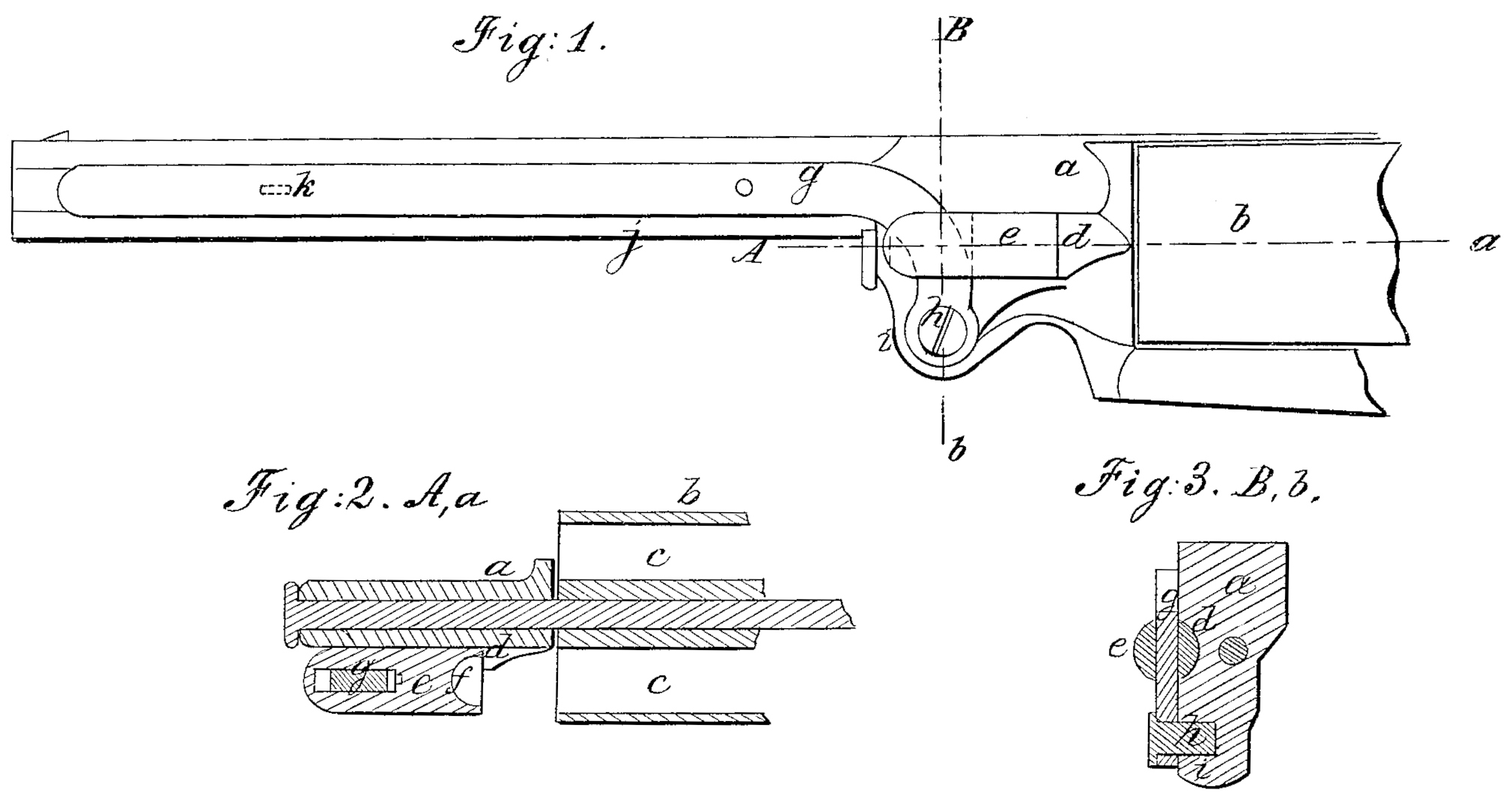USA 17044
UNITED STATES PATENT OFFICE.
JAMES KERR, OF LONDON, ENGLAND.
IMPROVED RAMMER FOR MANY-CHAMBERED BREECH FIRE-ARMS.
Specification forming part of Letters Patent No. 17,044, dated April 14, 1857.
To all whom it may concern:
Be it known that I, James Kerr, a subject of the Queen of Great Britain, residing in the city of London, England, have invented a new and useful improvement in Rammers for Many-Chambered Breech Fire-Arms, of which the following is a full, clear, and exact description, reference being had to the accompanying drawings, making part of this specification, in which—
Figure 1 is a side view of a pistol with my improved rammer applied, and Figs, 2 and 3 sections taken at the lines A a and B b of Fig. 1.
The same letters indicate like parts it all the figures.
My said invention is applicable generally to that class of fire-arms in which the charges are contained in a series of parallel chambers made in a rotating cylinder-breech so located within an iron body or frame that when rotated the several chambers shall be brought in succession to the line of the barrel; and my said invention consists in the arrangement of a cylindrical rammer fitted to slide in a guide groove made in the side of the iron body or frame which surrounds the rotating breech, and so located that by the rotation the several chambers can be brought in succession in line with the rammer, the said rammer being operated by a cam-lever turning on a fulcrum-pin at the side of the body or frame, and the cam part sliding in a mortise in the rammer, so as to give to the said rammer a longer range of motion than could be obtained by the lever action alone.
In the accompanying drawings, a represents the iron body or frame, in which the breech b, with its series of chambers c, rotates. One side of this body or frame is formed with a longitudinal groove, d, which in its cross-section presents a segment of a circle, and to this groove is fitted a cylindrical rammer, e so that when held therein it can be moved up and down freely and in a line with the chambers c as each in succession is brought to the required position by the rotation of the breech. That end of the rammer which acts on the ball to be rammed should be made of the reverse shape of the ball, as at f and near the other end it has a mortise made through it to receive the cam-lever g, which passes through and works in it. The part of the said lever g which works in the mortise of the rammer is curved in the segment of a circle, or nearly so, and the extremity beyond the curve turns on a fulcrum pin, h, which is tapped into the side of a projection, i, of the body or frame a, below the barrel j. The inner face of this lever lies against the side of the body or frame a, and the handle part along the side of the barrel when the rammer is drawn out to its greatest distance from the breech. The inner face of the handle is notched to catch on a projecting pin, k, (shown by dotted lines in Fig. 1,) on the side of the barrel, the handle of the lever being sufficiently thin to act as a spring-catch to hold the rammer away from the breech.
From the foregoing it will be seen that as the lever is fitted in the mortise of the rammer and is held against the face of the holy or frame at the rammer will be held thereby in the grooved, which thus becomes the guide to the motions of the rammer to force the ball into any one of the chambers when brought in line; and it will also be seen that the rammer is operated not only by the lever action, but, by the cam force of that part of the lever which slides in the mortise, thereby giving the rammer a greater range of motion than could be imparted to it by the lever action alone, while at the same time the whole is made compact and snug, liable to derangement, and cheap in the construction.
I do not wish to be understood as limiting my claim of invention to the peculiar form of the can part of the lever, or to the manner of catching and holding it against the barrel, as these may be modified within the range of my invention.
What I claim as my invention, and desire to secure by Letters Patent, is—
Fitting the rammer for ramming the charges in the chambers of the rotating breech of fire-arms in a longitudinal groove it the side of the body or frame, substantially as described, in combination with the cam-lever fitted to a mortise in the rammer for operating it in a manner substantially as described.
JAMES KERR.
Witnesses:
C. A. Seward,
R. S. Ripley.

